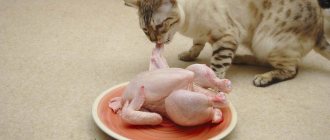To protect your cat from new pregnancies, she can be sterilized (in a cat this means removal of the ovaries) or castration (removal of the ovaries and uterus). Veterinarians recommend sterilizing a cat if mating is not planned. The fact is that in the absence of mating, periodically recurring estrus over time depletes the pet’s nervous system.
Indications for sterilization
Sometimes cats develop diseases that simply require castration:
- Inflammation of the reproductive organs, characterized by damage to their walls.
- Infections and injuries that can be inherited by offspring.
- Pyometra. This pathology is characterized by inflammatory processes of the uterus, which leads to increased accumulation of pus.
- Hematometra. Accumulation of blood in the uterus.
- Hydrometer. Accumulation of fluid in the uterus.
- Endomteritis. Inflammation of the uterus.
All these indications boil down to one conclusion - urgent castration of the animal is required (i.e. removal of both the ovaries and the uterus). Only with endometritis can you not rush into surgery and simply give your cat special medications and injections. However, at some point an intervention will still be required.
Castration
It is the surgical removal of reproductive organs: the ovaries and uterus in a cat, or the testicles in a cat. The operation is performed under general anesthesia. There are several methods of castration.
Most often, females have all their reproductive organs removed: the ovaries, uterus and fallopian tubes. But in some cases (young cats) the uterus is left.
Castration of a female is an abdominal operation, a fairly serious surgical intervention. Therefore, it makes sense to spend money on endoscopic (laparoscopic) castration .
This is the most modern and least traumatic method. The instruments are inserted through two (sometimes three) small incisions on the abdomen, which greatly reduces the risk of infection in the abdominal cavity, facilitates and shortens the postoperative period. The incisions are so small that stitches are not required - they are sealed with medical glue.
Castration is a surgical procedure
Is it possible to sterilize a cat that has given birth?
It is best to sterilize a cat not after giving birth, but immediately before the first heat, i.e. about a year. However, castration is also possible after childbirth, for the indications listed above or if there is no need for mating.
Also read the article about when is the best time to spay a cat.
Sometimes a cat is operated on during pregnancy. But this is carried out exclusively on the recommendation of a veterinarian and is practiced extremely rarely due to possible complications.
Veterinarian recommendations
Below are some recommendations based on the most frequently asked questions about this surgery.
- Before performing surgery, the age of the cat must be taken into account. Intervention performed too early or late entails many complications.
- Nursing cat mothers need to delay sterilization until the end of the lactation period. The body will fully recover in at least 2 weeks after the kittens are taken from their mother.
- If the cat does not feed the offspring, the operation cannot be performed earlier than a month after birth.
- A cat needs to give birth at least once before being spayed - a common misconception. This in no way affects the health of the pet or the operation. If you do not need kittens in the future, you need to sterilize at the earliest possible date.
- Before 4 weeks of pregnancy, it is quite possible to carry out sterilization, if necessary.
- Get tested and get the necessary vaccinations, they will help protect your pet from infection.
Mr. Cat recommends: what to feed a cat after sterilization
A pet that has undergone surgery needs special care and extra attention.
The pet is only allowed water for the entire day after surgery. On the second day, the cat is fed meat, fish or wet food twisted through a meat grinder.
The main thing to remember is that after sterilization, the cat’s digestive system noticeably weakens, so it cannot cope with solid food. Food should not be hot or cold. The food is heated until warm.
You can also learn more about how to feed a cat after spaying or neutering, and what food is best to give her.
Caring for an operated animal
After surgery, the animal requires special care.
If you are given a cat who has not yet recovered from anesthesia, it should be carefully brought home in a carrier and placed on a clean, warm bedding.
After surgery, your pet may not be able to control the urge to defecate or urinate.
It is advisable to limit active movements for several hours after surgery, as the cat’s coordination of movements may be impaired.
You should start feeding her with a teaspoon and little by little to avoid vomiting.
When getting an animal, you should remember the words of the wonderful writer Saint-Exupery: “We are responsible for those we have tamed.”
Contraindications
In some cases, sterilization is contraindicated. Causes:
- Allergy to certain medications.
- The disease and the period immediately after it.
- Recent injury.
- Individual intolerance to anesthesia.
In any case, the cat must first be examined by an experienced veterinarian and give an opinion. Additional examination may be required to identify other contraindications.
Castration is not recommended after 10 years of age, since the risk of postoperative complications is very high. The same applies if the cat is too young; surgery can slow down the development of the animal.
What age is most preferable?
The opinions of veterinarians at what months can sterilization or castration be carried out vary. Some veterinarians believe that the procedure can be performed at any age.
Others believe that the best age for it is from 6–8 months to a year and a half, i.e., with the onset of puberty.
There is no limit to how old the operation can be - it is successfully performed on parous and nulliparous adult cats at 3–5 and 7 years of age. The main condition is that the pet is healthy at this time.
During heat
It is not recommended to spay or neuter an animal while it is walking. At this time, the reproductive organs are filled with blood, so there is a risk of high blood loss. You should wait out this period and carry out the operation immediately after it.
The most optimal solution would be to spay or neuter the cat before her first heat.
If the cat is pregnant
An animal must be spayed or neutered before or after pregnancy.
During the operation, the veterinarian removes the ovaries and the uterus, which contains the fetuses. This leads to enormous stress for the cat, heavy blood loss and other complications.
This procedure is only possible up to 6 weeks of pregnancy. If the pregnancy is at an early stage (up to 3 weeks), the owners do not always know about it. In such cases, sterilization (castration) takes place without problems.
After childbirth
To spay or neuter a cat that has recently given birth, it is better to wait until she has finished nursing her kittens. That is, she can undergo surgery a couple of months after lambing.
Of course, the pet must be healthy.
Complications
Complications can be expressed in the form of lethargy and drowsiness, enlarged mammary glands, hernia, lack of appetite, abnormal bowel movements, changes in body temperature, the appearance of a rash, bleeding of the suture, heavy breathing, accompanied by wheezing, pallor or redness of the mucous membrane. Typically, all these symptoms go away on their own within a day or two.
Before surgery, the cat is given an anesthetic drug of minimal toxicity that does not have a negative effect on the body. Despite this, anesthesia causes its own complications: blood pressure rises, metabolism slows down, the pulse may become irregular, and allergies may appear. The result can be heart failure or even anaphylactic shock.
Why is surgery necessary?
Some animal lovers believe that sterilization is a manifestation of cruelty and human selfishness. However, mating with unknown cats on the street is a direct road to infection with external parasites, helminths, skin diseases, sexually transmitted infections and dangerous viruses.
In addition, continuous childbirth is an inevitable risk and stress that exhausts the body and can lead to severe exhaustion.
An important aspect of frequent births is the need to accommodate baby kittens each time. It is not always possible to give them to friends, especially if your pet gives birth regularly.
Sometimes you have to give kittens to someone unknown. Babies may end up with owners who skimp on food, treatment and maintenance, and ultimately throw them out onto the street.
It’s scary to imagine how many little kittens are drowned or thrown into the trash simply because the cat’s owner allowed her to give birth to several litters!
One should feel sorry for an animal that suffers from sexual dissatisfaction. The cat is looking for a partner, tearing furniture and wallpaper, marking, causing displeasure and sometimes aggression of the owners. Isn't it cruel to take her into the house and limit communication with the opposite sex?
Three factors speak in favor of sterilization:
- reducing the risk of many dangerous and even fatal diseases that are associated with the reproductive system of the body;
- improvement of behavioral characteristics;
- solving the problem of a large number of homeless animals.
If the animal is not participating in the breeder's breeding program, surgery is simply necessary.
Postoperative period
The cat should be kept warm for the first hours after surgery . It is strictly forbidden to place an animal near a radiator or in a draft (windows and vents in the house must be closed). Make your cat a cozy nest in her carrier by placing a heating pad next to her .
Every 30 minutes the animal must be turned from one side to the other. If your cat's eyes are slightly open, you should periodically close her eyelids and gently massage her eyeballs. This will help avoid chapping of the cornea.
In the first two days the animal may need pain relief..
Naturally, the cat itself will not ask for this, so it is important to get a doctor’s recommendations in advance and carefully monitor your pet. Signs that an animal is experiencing excessive pain include :
- aggression;
- refusal to eat;
- matched paws;
- immobility;
- dilated pupils.
Painkillers will ease the animal’s condition and reduce the effect of pain on the functioning of vital organs.
After surgery, the cat is covered with a blanket that protects the stitches . The animal may pull the blanket and try to lick the seams. Particularly persistent cats should wear a special collar. Usually the blanket is worn from 7 to 10 days .
The animal's appetite should normalize within the first two days . If your cat refuses to eat for more than 5 days, you should consult a specialist.
During the first few days, you may notice a decrease in urination in your cat. This is the norm. Increased urination or its complete absence is a reason to sound the alarm. If your cat has not had a bowel movement for three days, she should be given a mild laxative . For example, Vaseline oil in a dosage of 1 ml per 1 kg of weight.
Seams require special attention . They should be treated daily with a drug prescribed by a veterinarian. It is usually recommended to wipe with a cotton pad soaked in a miramistin solution. After wiping, apply levomekol ointment.
IMPORTANT! You need to process the entire seam with all its folds. Sometimes owners wipe the seam superficially - this is not enough!
On average, seam treatment lasts for 10 days. It is convenient to do this together: one person puts the cat on its hind legs and supports it in an upright position. The second one rolls up the blanket and processes the seams, after which he returns the blanket to its place.











